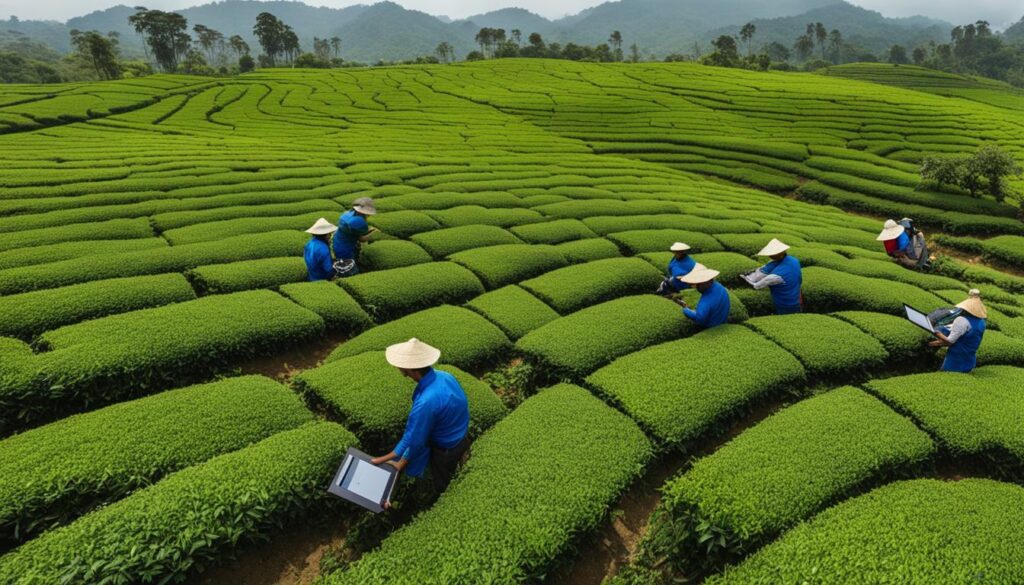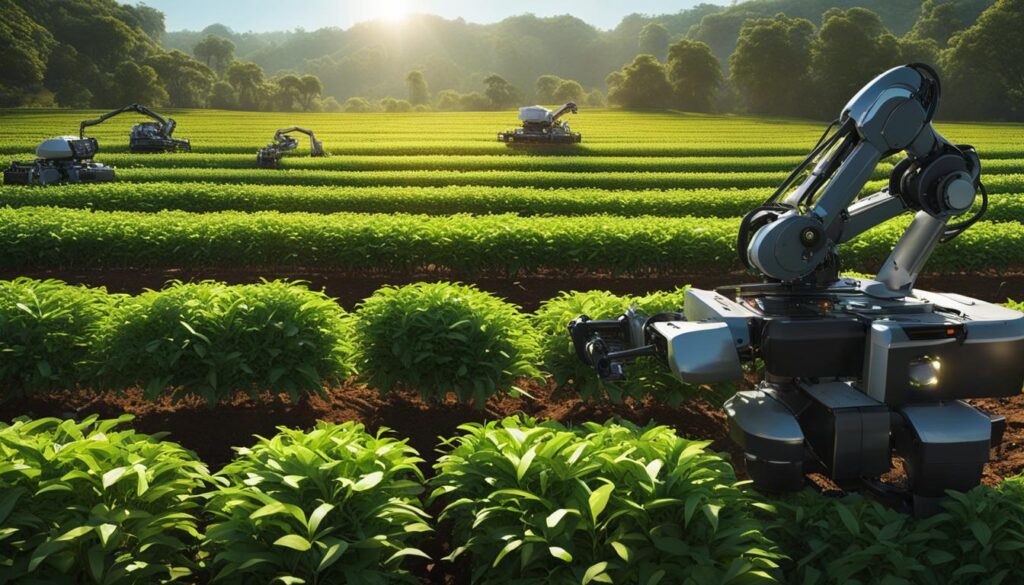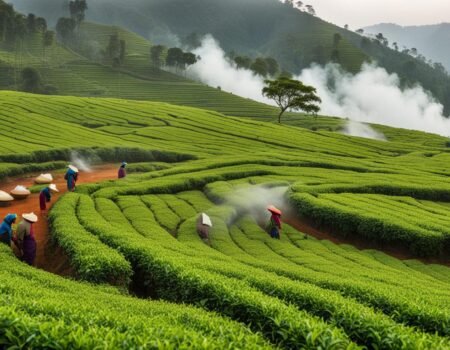
Incorporating Technology in Tea Harvesting Operations: Trends and Innovations
Tea cultivation has a long history, and technology has always played a role in the industry. Today, modern tea cultivation heavily relies on machines and computer programs. The tea industry is booming, with a projected value of $465.3 million by 2030. To meet the increasing global demand and improve sustainability, agri-tech solutions are being implemented. These solutions leverage technologies like AI, remote sensing, precision agriculture tools, and data analytics to optimize tea harvesting operations and improve efficiency.
Key Takeaways:
- Technology is transforming the tea industry, enhancing efficiency and sustainability.
- AI, remote sensing, precision agriculture tools, and data analytics are key technologies driving the innovation in tea harvesting operations.
- The integration of technology in tea production improves resource utilization and crop management.
- Automated tea picking robots and advanced processing techniques ensure higher yields and consistent quality.
- The future of the tea industry will see continued advancements in technology-driven innovations.
Smart Farming and the Tea Industry
Smart farming is revolutionizing tea production, ushering in a new era of efficiency and sustainability. By incorporating cutting-edge technologies such as AI, IoT, and sensor technology, tea farms can now monitor and optimize cultivation practices in real-time.
With the help of sensors, valuable data on weather conditions, soil quality, and other factors that impact tea growth can be collected. This data is then analyzed using AI algorithms, allowing farmers to make informed decisions about cultivation activities, resource allocation, and pest management.
By embracing smart farming, tea producers can achieve increased resource efficiency, better crop management, and improved sustainability in the industry. It also enables proactive management of tea plantations, leading to higher yields and healthier tea crops.

Benefits of Smart Farming in Tea Production:
- Real-time monitoring and optimization of cultivation practices
- Improved resource efficiency and reduced environmental impact
- Better crop management and increased yields
- Proactive pest and disease management
- Enhanced sustainability and profitability
Quotes:
“Smart farming is transforming the tea industry by enabling us to make data-driven decisions and optimize every aspect of cultivation. With real-time monitoring and AI analysis, we can ensure that our tea crops are thriving and our practices are sustainable.”
“By embracing smart farming technologies, we have been able to increase our tea production while reducing resource waste and environmental impact. It’s a win-win situation for both our business and the planet.”
In conclusion, smart farming is a game-changer in the tea industry. By harnessing the power of AI, IoT, and sensor technology, tea farms can achieve greater efficiency, sustainability, and profitability. With real-time monitoring and data-driven decision-making, tea producers can elevate the quality of their crops and ensure a brighter future for the industry.
Advancements in Tea Harvesting Robotics
Robotic solutions are revolutionizing tea harvesting operations, offering increased efficiency and productivity for tea farmers. These automated robots have been specifically designed to pick tea leaves with precision, reducing the need for manual labor and streamlining the harvesting process. With their advanced capabilities, tea harvesting robotics are transforming the tea industry, leading to higher yields and reduced costs.
The efficiency of tea harvesting robotics is a key advantage. These robots can work tirelessly and at a faster pace compared to human labor, allowing for a significant increase in harvesting speed. This results in quicker turnaround times, ensuring that tea farmers can meet the demands of the market effectively. Additionally, the precision of tea harvesting robots minimizes the risk of damage to the tea leaves, maintaining the quality of the final product.
Robotic solutions for tea farms are not only efficient but also cost-effective in the long run. While the initial investment may be higher, the reduction in labor costs and increased productivity result in significant savings over time. Tea farmers can optimize their resources and allocate labor to other essential tasks, enhancing overall farm management and profitability.

The Role of Technology in Tea Processing
Technology plays a crucial role in tea processing, revolutionizing traditional methods and improving efficiency and quality. Automation in tea processing has significantly streamlined the workflow, reducing manual labor and ensuring consistent results. Advanced technology is now used in various stages of tea processing, from leaf quality assessment to optimizing processing parameters.
Innovations in Tea Processing
One of the key innovations in tea processing is the automation of workflow. Machines now handle tasks such as withering, rolling, and drying, reducing the reliance on manual labor and increasing productivity. This automation not only saves time and resources but also ensures a more consistent quality of tea leaves.
Technology is also being employed in tea leaf quality assessment. Advanced systems can analyze parameters like size, color, and texture to determine the quality of tea leaves. This allows tea processors to ensure that only the highest-quality leaves are used, resulting in a superior end product.
Data Analytics in Tea Processing
Data analytics software is another technological tool that is transforming tea processing operations. By analyzing large amounts of data, processors can optimize processing parameters and make data-driven decisions. This leads to improved efficiency, reduced waste, and enhanced product consistency. Data analytics also allows tea processors to identify trends and patterns, enabling them to make strategic decisions to meet consumer demand.
Remote Sensing Technology in Tea Cultivation
Remote sensing technology is revolutionizing the way tea is cultivated, providing tea farmers with valuable insights and data to optimize their operations. Satellite imagery and drones are key tools in remote sensing, enabling tea farmers to monitor their farms remotely and gain a comprehensive understanding of plant health, growth patterns, and potential issues.
“Remote sensing technology has been a game-changer for the tea industry. With access to satellite imagery and drones, we can now remotely monitor our tea farms, allowing us to make well-informed decisions about resource allocation and cultivation practices. This has significantly improved our productivity and sustainability.”
By harnessing the power of remote sensing technology, tea farmers can proactively manage their plantations, making timely interventions to prevent pest and disease outbreaks. The use of drones in tea farm management allows for efficient surveying of vast areas, reducing the time and effort required for manual inspections. With these advancements, tea farmers can optimize resource allocation, minimize environmental impact, and improve overall farm efficiency.
Applications of Remote Sensing Technology in Tea Farming
- Monitoring plant health and growth: Satellite imagery and drones provide detailed information on tea plant health, enabling farmers to detect nutrient deficiencies, pest infestations, and disease outbreaks at an early stage.
- Identifying irrigation needs: Remote sensing technology helps tea farmers identify areas that require irrigation, ensuring optimal water usage and reducing water wastage.
- Evaluating crop yield: By analyzing satellite imagery, tea farmers can estimate crop yield, allowing for better harvest planning and resource management.
- Mapping tea farms: Drones equipped with cameras and sensors can create high-resolution maps of tea farms, providing farmers with accurate data on plantation boundaries and topography.
Overall, the integration of remote sensing technology in tea farming is revolutionizing the industry by empowering farmers with data-driven insights and enabling them to make informed decisions. From improving productivity to ensuring sustainability, remote sensing technology is shaping the future of tea cultivation.
Vertical Farming in Tea Production
Vertical farming is an innovative approach that is revolutionizing tea cultivation. This method involves growing tea plants in a vertical, controlled environment using hydroponic systems. The sustainable farming techniques used in vertical tea farms offer numerous advantages, making it a promising solution for the tea industry.
One of the key benefits of vertical farming in tea cultivation is the sustainability it offers. Vertical tea farms require significantly less land compared to traditional field cultivation, making them suitable for urban areas with limited space. Additionally, the controlled environment in vertical farms allows for optimal resource utilization, reducing water and fertilizer consumption. This sustainable approach promotes eco-friendly practices and helps preserve the natural environment.
Another advantage of vertical farming is the year-round production it enables. By creating a controlled environment, tea plants can be grown and harvested regardless of seasonal variations. This ensures a constant supply of tea crops, allowing farmers to meet the increasing global demand and reduce dependency on specific harvest seasons.
With the implementation of hydroponic systems, vertical tea farms eliminate the need for soil. This reduces the risk of soil-borne diseases and pests, resulting in reduced pesticide use. Vertical farming also allows for precise management of cultivation conditions, such as light, temperature, and humidity, ensuring optimal plant growth and tea quality.
The Future of Vertical Farming in the Tea Industry
As the tea industry continues to evolve, vertical farming is poised to play a significant role in its development. Technological advancements and the increasing demand for sustainable practices are driving the adoption of this innovative farming technique. With its numerous benefits, vertical farming has the potential to revolutionize tea cultivation, ensuring a reliable, high-quality supply of tea while minimizing environmental impact.
The Future of Technology in the Tea Industry
As the tea industry continues to evolve, technology will play a pivotal role in shaping its future. The advancements in AI, robotics, data analytics, and remote sensing are driving technology-driven innovations in tea farming. These innovations are set to have a profound impact on the tea market, revolutionizing both cultivation and processing operations.
The future trends in the tea industry will be characterized by increased automation, precision farming techniques, and data-driven decision-making. Tea farmers and businesses who embrace these advancements will gain a competitive edge in the evolving market.
One of the key advancements in tea farming is the integration of AI and robotics. Automated tea picking robots are revolutionizing the harvesting process, improving efficiency, and increasing yields. These robots can pick tea leaves with precision and speed, reducing the dependency on manual labor and decreasing operational costs for tea farmers.
In addition to robotics, remote sensing technology and data analytics are transforming tea cultivation practices. Satellite imagery and drones provide valuable data on plant health, growth patterns, and potential issues. This information enables farmers to make informed decisions about resource allocation, pest and disease management, and cultivation practices. By leveraging remote sensing technology and data analytics, tea farmers can optimize their operations, reduce costs, and proactively manage their plantations.
Conclusion
Technology has completely revolutionized the tea industry, impacting every stage from cultivation to processing. The integration of AI, robotics, remote sensing, and data analytics has brought remarkable benefits to tea farming.
Firstly, these technological advancements have greatly improved efficiency in tea harvesting operations. With the use of AI-powered robotic solutions and automation, tea farmers can achieve higher yields and reduce labor costs. The precision and accuracy of these technologies ensure the best quality tea leaves are picked, enhancing the overall product.
Furthermore, technology has enabled tea farmers to embrace sustainable practices. With remote sensing technology and data analytics, farmers can monitor tea farms remotely and make informed decisions about resource allocation, pest management, and cultivation practices. This proactive approach not only reduces costs but also minimizes the environmental impact of tea cultivation.
Looking ahead, the future of technology in tea harvesting operations is promising. We can expect even more advancements in AI, robotics, and remote sensing, leading to increased automation and precision farming techniques. These innovations will further optimize tea cultivation, improve quality, and ensure that tea farmers and businesses stay competitive in the evolving market.
FAQ
How is technology incorporated in tea harvesting operations?
Technology is integrated into tea harvesting operations through the use of AI, remote sensing, precision agriculture tools, and data analytics. These technologies optimize cultivation practices, improve efficiency, and enhance sustainability in the tea industry.
What is smart farming and how does it relate to the tea industry?
Smart farming is the integration of AI, IoT, and sensor technology in agricultural practices. In the tea industry, smart farming allows farms to monitor and optimize cultivation practices in real-time. Sensors gather data on factors like weather conditions and soil quality, which is then analyzed using AI to make informed decisions about tea cultivation activities.
Are there robotic solutions for tea harvesting?
Yes, robotic solutions are being developed to automate the tea harvesting process. These robots can pick tea leaves with precision and efficiency, reducing the need for manual labor. Automated tea picking improves the speed, accuracy, and productivity of tea harvesting, resulting in higher yields and reduced costs for tea farmers.
How does technology play a role in tea processing?
Technology plays a crucial role in tea processing by automating workflows, reducing manual labor, and ensuring consistent quality. Advanced technology is used for tea leaf quality assessment, analyzing parameters like size, color, and texture to determine the quality of tea leaves. Data analytics software is also employed to optimize processing parameters and improve the efficiency of tea processing operations.
How does remote sensing technology impact tea cultivation?
Remote sensing technology, including satellite imagery and drones, is used to monitor tea farms remotely. This technology provides valuable data on plant health, growth patterns, and potential issues, enabling farmers to make informed decisions about resource allocation, pest and disease management, and cultivation practices. Remote sensing technology improves efficiency, reduces costs, and enables proactive management of tea plantations.
What is vertical farming in tea production?
Vertical farming is an innovative approach to tea cultivation where tea plants are grown in a vertical, controlled environment using hydroponic systems. This method offers advantages such as reduced pesticide use, optimal resource utilization, and year-round production. Vertical tea farms eliminate the need for traditional field cultivation and provide reliable, high-quality tea crops.
How will technology shape the future of the tea industry?
Ongoing advancements in AI, robotics, data analytics, and remote sensing will continue to transform tea farming and processing operations. These technologies will enhance efficiency, improve quality, and enable sustainable practices. The tea industry will see increased automation, precision farming techniques, and data-driven decision-making in the coming years.
What are the benefits of incorporating technology in the tea industry?
Incorporating technology in the tea industry offers numerous benefits, including increased productivity, sustainability, and cost-effectiveness. Advanced technologies optimize tea harvesting operations, improve efficiency in tea processing, enable proactive cultivation management, and enhance overall product quality. Embracing technological innovations will be essential for tea farmers and businesses to thrive in the competitive market.






